Kao što
sam već obznanio OVDE, mom romanu ZADUŠNICE dodeljena je regionalna nagrada „Miodrag
Bulatović“.
.jpg)
Evo
nekih slika i nekih izjava, članaka i fragmenata o tome kako je to izgledalo i
šta je o tom romanu bilo rečeno, uključujući izveštaj s njegove promocije u
Nikšiću. Na samom kraju imate i link da
skinete i poslušate čitavu tu promociju.
.jpg)
Prof. dr Gojko Tešić je u obrazloženju Odluke žirija da književna nagrada
,,Miodrag Bulatović“ pripadne autoru Dejanu Ognjanoviću za roman ,,Zadušnice“ istakao da je riječ o
višeslojnom, modernom djelu koje donosi šokantnu novinu u savremenoj
književnosti.
.jpg)
,,Roman ,,Zadušnice“ Dejana
Ognjanovića je u mnogo čemu šokantna
novina u našem relativno mirnom romanesknom moru, iako živimo u morbidnim,
mračnim, crnim vremenima koja su, izvesno je, autoru bila velika inspiracija. Inovativnost je vidljiva i u formi, i u
strukturi, i u značenju, i u simbolici (...). Roman je satkan od građe iz
prostora fantastike, uslovno rečeno vezanog za Istočnu Srbiju – a sve to je u
nama i oko nas, „gogoljevski“ živo.
Ognjanovićevi junaci su deo i prošlosti, ali i junaci sadašnjosti, bez obzira što
pripadaju svetu mrtvih. Njihovo „buđenje“, njihov „govor“ i „dijalog“ su crnohumorne filmske storije koje nam
odjekuju i gledamo ih svakodnevno. Filmska priča, fantastična, hororska – to su
ključne oznake blistave ognjanovićevske
poetike koja se nadovezuje i na
bulatovićevsku grotesku, fantastiku, satiru, alegoriju,“ naveo je prof. dr
Tešić u saopštenju.
.jpg)
U ime žirija o djelu
„Zadušnice“ govorio je profesor dr emeritus Boguslav Zielinski, ambasador svih književnosti i kultura s bivšeg
jugoslovenskog prostora, zaslužan za njihovu promociju u Poljskoj, naglasivši
da ,,roman preporučen za nagradu ima složenu
i višeslojnu strukturu stvorenu Bahtinovom karnevalizacijom svijeta naopačke,
povezanom s kategorijom grotesknog, rableovskim
naturalizmom s njegovom posebnom sklonošću hiperboli, deformaciji i tjelesnosti, kao i demitologizacijom, fantazijom, simbolizmom i parodijom koji roman
povezuju s tradicijom Bulatovića. Posebnost djela je vizualizacija, koja se jasno očituje u motivu apokalipse“, istakao je Zielinski.
.jpg)
Književna nagrada „Miodrag
Bulatović“, za najbolji roman u kategoriji karnevalske, groteskne i fantastične
književnosti objavljen u 2023. i 2024. godini, dodijeljena je autoru Dejanu
Ognjanoviću, za roman „Zadušnice“, odlukom međunarodnog žirija u sastavu: prof. dr Gojko Tešić, predsjednik žirija, i
prof. dr Boguslav Zjelinski, prof. dr Andrea Lešić-Tomas, prof. dr Miranda
Levanat-Peričić i doc. dr Tamara Labudović, članovi.
.jpg)
Nagradu su Ognjanoviću uručili
ćerka i sin Miodraga Bulatovića,
Barbara i Matija Bulatović, a potom se nikšićkoj publici obratio Dejan
Ognjanović, istakavši da je višestruko počastvovan da primi ovu nagradu:
,,Počastvovan sam pre svega zato što nosi ime našeg velikog pisca, sa kojim
sam, eto, doveden u vezu. Naravno, nije na meni da uopšte pomenem sebe u istoj
rečenici sa njim, ali zahvaljujem onima koji su procenili da se to može
učiniti. Počastvovan sam i što dobijam ovu statuu koja nosi njegov lik, i zato
što mi ovu nagradu uručuje regionalni žiri sastavljen od izuzetno eminentnih
članova. Svako od njih pojedinačno je izuzetno kompetentan da donese ovaj sud
koji je doneo, i naravno, drago mi je da ovu nagradu dobijam u bratskoj Crnoj
Gori. Pozdravljam ovu manifestaciju i njen koncept – koncept ovog Karnevala
romana i, uopšte, ideju da se nagrađuje ovakva vrsta romana. Ova nagrada je
zaista jedinstvena i nema pandana, bar koliko je meni poznato. Ovo nije nagrada
za žanrovski roman, ovo nije nagrada za mejnstrim roman, već nagrada za jednu
vrlo specifičnu vrstu romana koja je groteskna, satirična, fantastična,
preterana, subverzivna, i to je dodatni razlog zašto meni imponuje da budem
jedan od njenih laureata.“
.jpg)
Ognjanović je naglasio da ,,Mi
živimo u jednoj globalnoj karnevalizaciji, klovnovi su preuzeli mesta
državnika. Njihove izjave i njihove slike su sada mimovi, dakle, ono što danas
govore predsednici postaje predmet sprdnje i taj humor je gorak. Oni pričaju
svašta i rade svašta, ali kada se setite da je takav i predsednik najmoćnije
zemlje na planeti, a kamoli ovi drugi koji drže naše sudbine u rukama – taj smeh
na njihove urnebesne izjave i ponašanje je gorak, kao što je gorak i crn humor
u mom romanu, i zastrašujući. Taj spoj horora i humora moj roman čini itekako
angažovanim, i ja sam zahvalan žiriju što je to prepoznao“, zaključio je
Ognjanović.
.jpg)
Evo i
nekoliko fragmenata iz članka sa RTV Nikšić, sa promocije ZADUŠNICA.
Dejan Ognjanović, dobitnik
priznanja „Miodrag Bulatović“, koje dodjeljuje Narodna biblioteka „Njegoš“,
osim nagrađenog „Zadušnice“, autor je romana „Naživo“, „Zavodnik“ i
„Prokletije“ i zbirke priča „Divlja kapela“. Dva puta našao se u užem izboru za
značajna regionalna i međunarodna knjižena priznanja – za vodeću svjetsku horor
nagradu Brem Stoker 2022., u konkurencije eseja i za NIN-ovu nagradu 2024, za roman
„Zadušnice“.
.jpg)
„Ovo je prva zaista velika, ozbiljna knjižena nagrada.
Mislim, čisto da ne budem nepravedan, osvojio sam na konkursu jednog časopisa
treće mesto za kratku priču pre 15. godina. Da, nije to zaista nešto naročito
za hvalu, ali eto, nije baš da nije ništa bilo primećeno, i da, bio sam sa
„Zavodnikom“ u širem izboru za NIN-ovu
nagradu, a sa ovim romanom u užem izboru.
U užem izboru sam se našao i to je zapravo doslovno najveći plasman koji je
jedan horor roman ikada u dosadašnjoj istoriji prišao, dakle, da dođe među 12
romana za NIN-a. Naravno, druga vrsta stvari se nagrađuje, ja nisam očekivao da
to dospe i dotle, i hvala im na tome, lepo je, lepo je biti primećen, ali „za
malo“ nije nagrada“ – istakao je Ognjanović..jpg)
Od 2015. urednik je edicije
„Poetika strave“ u izdavačkoj kući „Orfelin“, čiji je nastanak inspirisala
zapravo Ognjanovićeva doktorska disertacija „Istorijska poetika horor žanra u
angloameričkoj književnosti“, kazao je direktor Orfelina, Milenko Bodirogić.
.jpg)
„Edicija Poetika strave ima
blizu 40 naslova i na lep način pratio tu, po meni, Dejanovu kapitalnu studiju „Poetika horora“.
Dakle, taj slučajan susret sa Dejanom je, na neki način, usmerio dve trećine
izdavačke delatnosti Orfelina, koja nikad nije imala namera da bude nekako snažna,
velika, naprotiv. Ali evo, sad je to gotovo 40 knjiga o „Poetici strave“ I peta
knjiga u ediciji „Crna mačka“ – pojasnio je Bodirogić..jpg)
Svaka knjiga iz edicije
„Poetika strave“ nosi Ognjanovićev pečat. Naime, on je autor predgovora koje
piše iz naučnog i ugla eksperta horor žanra. Uskoro će se pred publikom naći i
njegova tetralogija.
„Inače, Dejan sad radi na
nečemu što je možda buduća tetralogija od koje ja poznajem koncepciju prve dve
knjige. Jedna se zove Dolazak književnog horora, a druga Dolazak
filmskog horora“ – kaže Bodirogić.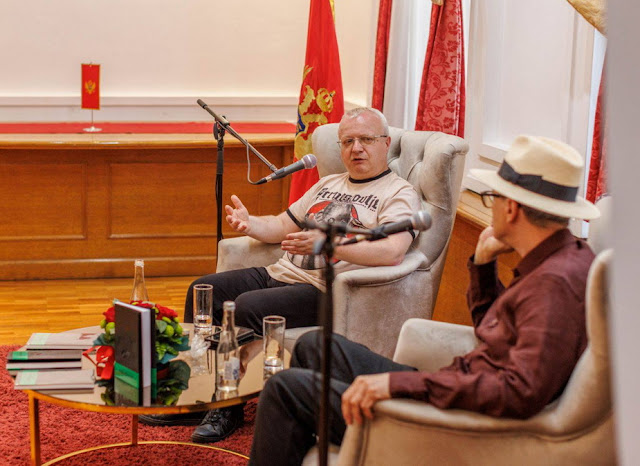.jpg)
Nagrađeni roman „Zadušnice“
drugačiji je od ostalih, jer posjeduje dozu humora, kaže autor.
„Ja nisam siguran koliko je on
vedriji zbog tog humora, jer je on veoma mračan
i morbidan, ali ajde recimo da tu svakako ima mnogo više povoda za smeh
čitaoca nego u nekim mojim drugim romanima“ – istakao je autor.
Razgovor sa Ognjanovićem i
Bodirogićem, koji su bili gosti Narodne biblioteke „Njegoš“, drugog
festivalskog dana književne manifestacije „Karneval romana“ vodio je Darko Nikolić.
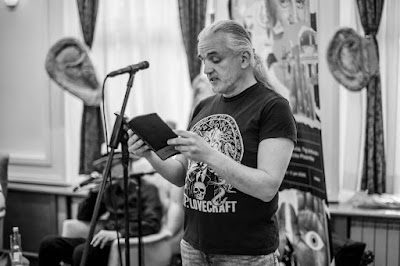.jpg)
Preuzeto odavde:
https://rtnk.me/kultura/video-niksickoj-publici-predstavljen-roman-zadusnice/
„Uprkos snažnim grotesknim momentima, u izvjesnom smislu
je ovo moj najcrnji roman, jer opisuje Srbiju kao zemlju mrtvih, zemlju u kojoj
je život (skoro) nemoguć. Ukratko, ako tu ima nekog humora on je ponajviše u
duhu Tomasa Bernharda i Vilijama Barouza, samo sa malo više zgražavajućih
prizora“, naveo je Ognjanović.
.jpg)
Na svom blogu pisac je
objasnio da je roman „Zadušnice“ duboko ukorijenjen u ovdašnjem ambijentu i
mentalitetu i da, onako kako je zamišljen i insceniran, nigdje drugdje ne bi
mogao da se odigra, a dodatnu draž unosi činjenica da se radnja romana odvija u
niškom kraju i da obiluje južnjačkim dijalektom.
Pogovor za roman, pod nazivom
„Veseli domaći horor“, napisao je Ilija Bakić, pisac i kritičar,
koji je naglasio da su „Ognjanovićeve stilske vježbe na temu oživjelih mrtvaca
uspjele da žanrovske obrasce izdignu iz rutinske ovještalosti zahvaljujući
visprenom insistiranju na veselom lokalnom koloritu koji ovim pričama donosi
dobrodošlu notu razgaljujuće grotesknosti“..jpg)
Preuzeto odavde:
https://www.vijesti.me/vijesti/kultura/760058/dejan-ognjanovic-dobitnik-nagrade-miodrag-bulatovic
Osjećam se autsajderom i njegujem tu poziciju
Drugog dana manifestacije
“Karneval romana”, predstavljena knjiga “Zadušnice” za koju je pisac Dejan
Ognjanović dobio nagradu “Miodrag Bulatović”
.jpg)
"Ne osećam se komotno u srpskoj
književnosti. Nominalno, ja jesam njen deo, ali nekako niti ona mene primećuje,
niti ja nju primećujem, niti se ona mnome bavi, niti se ja bavim njome, tako
da, verovatno, nisam ni na radaru većine srpskih književnih kritičara – delom
mojom odlukom, delom činjenicom da su svi moji romani i zbirka kratkih priča –
samizdat. Osećam se autsajderom i negujem tu autsajdersku poziciju, odnosno ne
bunim se, nemam pretenzije na neke glavne nagrade i uopšte književne krugove
pripadanja. Takođe, sopstvenom odlukom, nisam član ni jednog udruženja”, kazao
je Dejan Ognjanović u okviru drugog dana književne manifestacije “Karneval
romana” i promocije njegovog romana “Zadušnice”, za koji je dobio nagradu
“Miodrag Bulatović”, koju dodjeljuje Narodna biblioteka “Njegoš” iz Nikšića.
Ognjanović je pisac, književni
i filmski kritičar, teoretičar, istraživač, čovjek koji se, kako to reče tokom
razgovora, jednako udobno osjeća i u
ulozi pisca i u ulozi kritičara.
.jpg)
“Zaboravio sam ko je autor
citata, ali neko je književnog kritičara definisao kao osobu bez nogu koja
druge podučava kako treba da trče. To je možda jedan od razloga koji me je
naveo na to da neću da budem taj bez nogu koji će drugima pričati kako se trči,
nego ću se okušati, verovatno ne sa istim uspehom, i u ulozi pisca. Podjednako
komotno se osećam u obe te pozicije i trudim se da one ne smetaju jedna drugoj:
da kada stvaram prozu ne stvaram kao nekakav profesor, teoretičar koji će istog
trenutka da to analizira, mehanički gradi, već da kao stvaralac budem što
spontaniji”, kazao je Ognjanović.
Godinama pokušava da horor
izdigne na novi umjetnički nivo i da, naglašava, dokaže da horor može da bude ozbiljna književnost.
.jpg)
“Horor je izuzetno relevantan
žanr u književnosti, nažalost, potcenjen, neshvaćen. Niko ga ovde nije ni
plasirao ni tretirao na pravi način a potpuno je relevantan i odbranjiv u
estetskom smislu. Trudim se i na delu, i kao pisac, da to ne bude nekakav
eskapizam, neka trivijalna literatura, nego nešto što ima poentu”.
Osim nagrađenog romana
“Zadušnice”, autor je još tri romana “Naživo”, “Zavodnik” i “Prokletije” i
zbirke priča “Divlja kapela”. Dva puta se našao u užem izboru za značajna
regionalna i međunarodna knjižena priznanja - za vodeću svjetsku horor nagradu
Brem Stoker, u konkurenciji eseja, i za NIN-ovu nagradu za roman “Zadušnice”.
.jpg)
“Bio sam sa ‘Zavodnikom’ u
širem izboru za NIN-ovu nagradu, a sa ovim romanom u užem izboru. To je najveći
plasman kome je jedan horor roman ikada u dosadašnjoj istoriji prišao, da se
nađe među 12 romana za NIN-ovu nagradu. Naravno, druga vrsta stvari se
nagrađuje, ali nisam očekivao da stigne ni dotle, i hvala im na tome, jer lepo
je biti primećen”, istakao je Ognjanović koji je 2012. godine prvi u Srbiji,
ali i u regionu, odbranio doktorsku disertaciju u cjelosti posvećenu poetici
horora (“Istorijska poetika horor žanra u anglo-američkoj književnosti”).
“Zadušnice”, roman koji je
objavljen krajem 2023. godine, gotovo četvrt vijeka nakon Ognjanovićeve zamisli
o njegovom nastanku, a nagradu “Miodrag Bulatović” je dobio u kategoriji
karnevalske, groteskne i fantastične književnosti, prema riječima autora,
sadrži najviše humora, u odnosu na dosadašnja njegova djela, ali, kako je
kazao, nije siguran koliko je “zbog tog humora vedriji”.
“Jer je on veoma mračan i
morbidan, ali recimo da tu ima mnogo više povoda za smeh čitaoca nego u nekim
mojim drugim romanima”, istakao je autor koji smatra da je jezik piščeva
domovina i koji se pridržava toga da piše o onome što zna.
.jpg)
Od 2015. godine Ognjanović je
urednik edicije “Poetika strave” u izdavačkoj kući “Orfelin”, čiji je
osnivač Milenko Bodirogić, i do sada je, u pomenutoj
ediciji, objavljeno skoro 40 naslova, a svaki od njih nosi Ognjanovićev pečat -
autor je opsežnih predgovora koji imaju i po 90 stranica i koje piše iz naučnog
i ugla eksperta horor žanra.
“Treba reći da je Dejan, pored
svoje skromnosti, jako vrijedan i akribičan. On ima akademski pristup radu i meni je žao što mu je to onemogućeno.
Dejan sad radi na nečemu što je možda buduća tetralogija od koje ja poznajem
koncepciju prve dvije knjige. Jedna se zove ‘Dolazak književnog horora’, a
druga ‘Dolazak filmskog horora’”, kazao je Bodirogić.
Razgovor sa Ognjanovićem, koji
važi za vodećeg poznavaoca horor žanra, na Balkanu, što u književnosti, što u
kinematografiji, i sa Bodirogićem, čija knjiga “Pesak pjeskare” će biti
predstavljena trećeg dana “Karnevala” vodio je Darko Nikolić.
Odavde:
https://www.vijesti.me/vijesti/kultura/761003/osjecam-se-autsajderom-i-njegujem-tu-poziciju
Ovo su
mediji koji su detaljnije izveštavali o ovoj nagradi:
https://www.vijesti.me/vijesti/kultura/760058/dejan-ognjanovic-dobitnik-nagrade-miodrag-bulatovic
https://www.danas.rs/kultura/dejan-ognjanovic-nagrada-miodrag-bulatovic/
https://www.art-anima.com/nagrada-miodrag-bulatovic-dejanu-ognjanovicu-za-roman-zadusnice/
https://rtnk.me/kultura/knjizevna-nagrada-miodrag-bulatovic-dr-dejanu-ognjanovicu-za-roman-zadusnice/
https://www.glassrpske.com/lat/kultura/knjizevnost/ognjanovic-laureat-nagrade-miodrag-bulatovic/581295
https://www.dan.co.me/kultura/nagrada-miodrag-bulatovic-dodijeljena-dejanu-ognjanovicu-5299459
https://www.vijesti.me/vijesti/kultura/761003/osjecam-se-autsajderom-i-njegujem-tu-poziciju
https://n1info.rs/kultura/dejan-ognjanovic-dobitnik-nagrade-miodrag-bulatovic/
https://rtnk.me/kultura/video-niksickoj-publici-predstavljen-roman-zadusnice/
(video)
https://www.dan.co.me/kultura/video-u-niksicu-otvoren-iv-karneval-romana-5300014
(ima audio snimak)
https://bibliotekank.me/?p=616
https://sfpisb.wordpress.com/2025/05/27/zadunice-dobile-nagradu-miodrag-bulatovic/
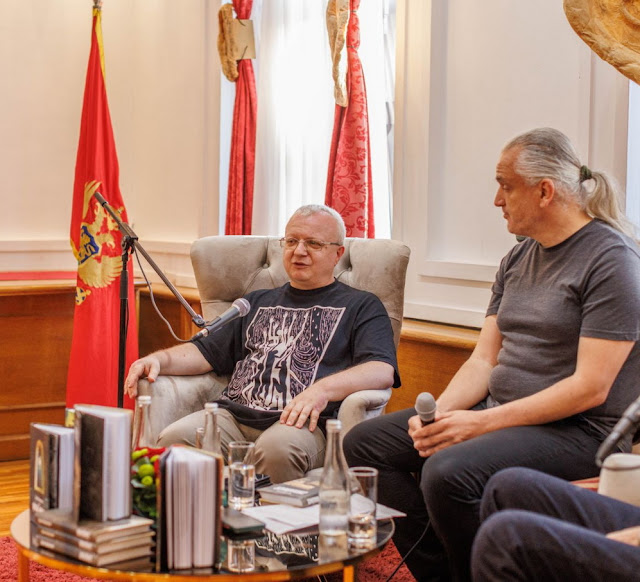.jpg)
VIDEO PRILOZI:
Sa promocije u Nikšiću:
https://www.youtube.com/watch?v=ero9scWIXNY
Gostovanje na TV KOPERNIKUS:
https://www.youtube.com/watch?v=xMt2WFuazAU
Ako vas
zanimaju moje impresije, ukratko rečeno – prezadovoljan sam i organizacijom, i
medijskom i svakom drugom ispraćenošću ovog događaja. Počastvovan sam, radostan
zbog priznanja mom proznom radu, ali po povratku kući nisam imao vremena da
spavam na lovorikama, nego sam se smesta bacio na radne zadatke: dovršavanje
knjige DOLAZAK KNJIŠKOG HORORA i pripremama za novo izdanje SLAUGHTER FESTIVALA
(imaćemo, izgleda, jednog dobrog gosta, i brdo ekskluzivnih, dobrih filmova).
.jpg)
O mom
dobrom raspoloženju na promociji ZADUŠNICA, 1. juna 2025. – kojem je sigurno
doprinelo i učešće Milenka Bodirogića – možete svedočiti i ako rešite da
poslušate audio snimak te promocije, odnosno razgovora koji je odlično vodio
Darko Nikolić. Mislim da smo sva trojica bili na nivou, i da je ovo jedan
sočan, zabavan i slušanja vredan razgovor.
Ima oko
120 MB, i možete ga jednim klikom skinuti, pa slušati, ODAVDE:
https://www.mediafire.com/file/ilavnokgnox0vte/Zadušnice+promocija+u+Nikšiću,+1.+jun.+2025.m4a/file















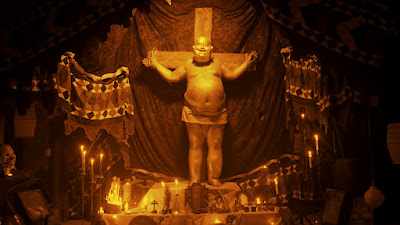

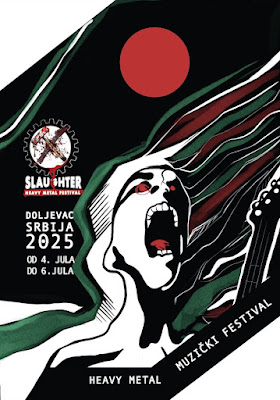

.jpg)



.jpg)

.jpg)

.jpg)
.jpg)
.jpg)
.jpg)
.jpg)
.jpg)
.jpg)
.jpg)
.jpg)
.jpg)
.jpg)
.jpg)
.jpg)
.jpg)
.jpg)
.jpg)
.jpg)
.jpg)
.jpg)
.jpg)
.jpg)
.jpg)
.jpg)
.jpg)
.jpg)
.jpg)
.jpg)
.jpg)
.jpg)